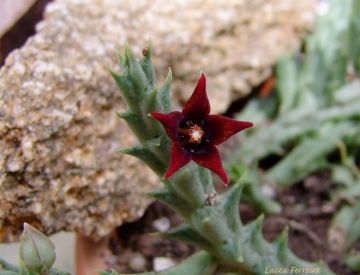Accepted Scientific Name: Orbea semitubiflora (L.E.Newton) Bruyns
Aloe 37: 76 2000

Angolluma semitubiflora (Orbea semitubiflora) Photo by: Luiza Ferreira
Origin and Habitat: This species has a limited distribution and is found only in the Arusha Province of northern Tanzania.
Synonyms:
Description: Orbea semitubifloraSN|31013]]SN|31010]] (formerly Angolluma semitubifloraSN|31011]]SN|31011]]) is a tufted perennial succulent of very free flowering habit. The flowers clustered at the ends of the branches are five-pointed fleshy stars 12 mm in diameter with dark wine-red lobes and a yellowish corona. As the name suggests the flowers have a brief bowl shaped tube.
Stems: Erect, spreading or decumbent, 4-angled to rounded, 6-9 cm long, greyish green mottled with brown to purple spots and stripes with prominent conical-subulate slender tubercles, 8-15 mm long and 3-5 mm wide horizontally spreading at the base with red stripes. The stems cluster and have rhizomatous runners.
Blooming season: Flowers throughout summer and into early fall.
Fruits: The fruit are paired spindle-shaped capsules (follicles), resembling the horns of an antelope, with the tightly packed seeds inside. At maturity they split open to release numerous small brown seeds crowned with long white hairs.
Related species: Vegetatively O. semitubiflora closely resembles Orbea denboefiiSN|31013]]SN|30503]] and Orbea dummeriSN|30564]]SN|30564]], so that these three species mostly cannot be distinguished when not in flower. All three may occur within close proximity of one another in some parts of Tanzania. From both of these species O. semitubiflora differs by the much smaller corolla tube and the low gynostegium, whose outer corona lobes are deeply excavated towards the middle. The other species of Orbea that grows in the area is Orbea subterraneaSN|30503]]SN|31013]], and O. semitubiflora differs from it by the larger flowers with a deeper corolla tube and the different-looking stems, in which the tubercles are not as strongly laterally flattened and are not as clearly united into rows. Plants of O. semitubiflora are mostly much less rhizomatous than those of Orbea subterraneaSN|31010]]SN|31013]]. They are in fact very variable in this feature, and in some of them the stems show no sign of underground growth at all.
Bibliography: Major references and further lectures
1) John Hunter Thomas “Systematic Botany Monographs” American Society of Plant Taxonomists, 2002
2) African Plants Database (version 3.4.0). Conservatoire et Jardin botaniques de la Ville de Genève and South African National Biodiversity Institute, Pretoria, Retrieved 6 Apr. 2015., from <http://www.ville-ge.ch/musinfo/bd/cjb/africa/>.
 Angolluma semitubiflora (Orbea semitubiflora) Photo by: Luiza Ferreira
Angolluma semitubiflora (Orbea semitubiflora) Photo by: Luiza FerreiraSend a photo of this plant.The gallery now contains thousands of pictures, however it is possible to do even more. We are, of course, seeking photos of species not yet shown in the gallery but not only that, we are also looking for better pictures than those already present.
Read More... Cultivation and Propagation: Orbea semitubifloraSN|31010]]SN|31010]] is ine of the easy Orbeas's to grow. Multiplies quickly from underground runners.
Spring: When winter ends and they begin to grow again, they will require much water and soaking the pots will no longer put the plants at risk for rot. In the spring they will grow well in partial shade and leaving them out in the rain may provide them with the water they need.
Summer: In the summer months they will tolerate heavy rain, but will be just as happy if the season is dry. It's best to sort out the stems while the plants are resting in the summer before they begin their autumnal growth cycle. They will tolerate very hot weather outdoors as long as they are kept in filtered light and this will encourage them to flower in the Autumn. They also enjoy some fertiliser. Moving the plants as they are developing buds may cause them to spontaneously abort the flowers all together.
Autumn: In the fall keep them outdoors until the night time temperatures drop below the 10°C.
Winter: Winter care presents no problems at 10° C with plenty of light. As soon as they are flowered be sure to take extra precautions to keep them dry, because damp cool conditions when the plants are resting is an invitation to fungal infections, but - according to temperatures –some occasional lit watering may be useful.
Potting medium: Since roots are quite shallow, use a cactus mix or add extra perlite or pumice to regular soil potting soil. A gritty, very free-draining compost is suitable, and clay pots help the plants to dry out between watering. Re-pot every 2 years.
Pest and diseases: Orbeas are generally fairly easy to grow, especially if kept pest-free. They are very susceptible to stem and root mealy bugs, and damage from these may well initiate fungal attack. Any time when there is a dead or dying stem in the pot it is important to remove it immediately and completely before other healthy stems can become ill too, isolate the healthy parts, dry them off, and re-root them in new compost.
Propagation: Easiest with stem cuttings. Allow cuttings to dry a day before planting. Stems must be laid (Not buried) on gritty compost and will then root from the underside of the stems. It can also be increased from seeds sowing in spring in moist, sandy peat moss. Barely cover seeds. Seeds germinate quickly.
In any season it's best to lay the stems out for several days before replanting them and then pot them only in dry soil and withhold any water until they begin to shrivel or start growing again.











